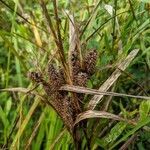Plants cespitose, short-rhizomatous. Culms 18–80 cm. Leaves 2.5–11.5 mm wide, sparingly scabrous. Spikes 3–7(–9), erect; lateral spikes pistillate with few staminate flowers at base and rarely also at apex, narrowly elliptic, 12–50 × 7–13 mm; terminal spike usually staminate, sometimes gynecandrous, pistillate, or abortive, 6–45 × 2–6 mm. Pistillate scales narrow, with indistinct body, 3.6–9(–11) × 0.1–0.4 mm, apex with long, scabrous awn exceeding perigynium. Staminate scales loosely to irregularly imbricate with tips spreading, linear, 4.3–15 × 0.3–0.8 mm, apex with long, scabrous awn. Perigynia horizontal, 3.5–6 × 1.4–2.6 mm, minutely pustulate; beak 1.3–2.2 mm, smooth. Achenes obovoid, sides strongly concave, 1.4–2.1 × 1–1.4 mm, less than 2 times as long as wide; style deciduous, straight or sinuous.

